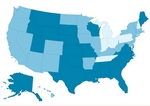Government
CMS revises rules limiting physician self-referral
■ A clearer regulation likely will mean stepped-up government enforcement.
By Tanya Albert amednews correspondent — Posted April 19, 2004
- WITH THIS STORY:
- » Stark II redo
- » Where the law applies
- » External links
- » Related content
Physician self-referral laws seem to be getting better with age, or at least easier to understand and more in line with how physicians practice.
On March 26, the Centers for Medicare & Medicaid Services published the third version of the 600-plus page regulation that governs how physicians make referrals to entities in which they have a direct or indirect financial relationship.
CMS made changes based on concerns voiced by physicians, health lawyers and others in health care. Experts say the latest version is clearer than those released in 1998 and 2001, and in some ways is more physician-friendly.
One of the biggest changes that should make doctors happy: Those who have been in compliance for 180 consecutive days but fall out of compliance for reasons beyond their control now have a 90-day grace period to re-comply.
But the government also has tried to close some loopholes. For example, the new rules make it harder for doctors to meet exceptions that allow them to share equipment, space and personnel for designated health services, including radiology and physical therapy.
"While they're not giving the industry everything it wanted, they've gone a long way in making improvements," said health lawyer Jeremy Miller, president of Miller Health Law Group in Los Angeles. "They have made good efforts to address unintended consequences and vague language."
The agency has "gone a long way in making the whole thing read more like English," added health lawyer William H. Maruca, a partner with Fox Rothschild in Pittsburgh. "People may not like or agree with the regulations, but they know where they stand."
CMS officials said they aimed to make the Stark II, Phase II, interim final rules conform to other government regulations and payment rules, to protect beneficiaries' access to care, to establish "bright-line" rules, and to make the rules simple when possible.
"Overall, there shouldn't be any additional burden on physicians trying to structure their business arrangements to comply with the law," CMS Acting Administrator Dennis Smith stated. "The regulation will not prevent doctors from continuing to provide high-quality health care services to their patients."
CMS is giving the public 90 days from the date the regulation was published to comment further on the rule before it becomes final.
Some nuts and bolts
In general, Stark prohibits physicians from referring Medicare and Medicaid patients to entities in which they or immediate family members have a financial interest. It applies to 11 designated health services.
Many of the revisions are helpful to physicians, legal experts said. For example, the new rules create a professional courtesy exception that allows doctors to provide free or discounted care to other physicians or their families. This means that the regulation now reflects the policy in the Physician Practice Compliance Guidance, which the Office of Inspector General provides to physicians.
The rules also help physicians by creating an exception for intra-family referrals for cases in which a patient resides in a rural area and there is nowhere else for the patient to get service in a timely manner.
In addition, the new version of the regulation relaxes the rules so that after a one-year lease of space expires, a physician can go month-to-month for up to six months. Previously, Stark required a physician to sign a one-year lease, creating a burden for a doctor who may intend to move into a new office space, but who needs an extra month or two in the current location because the new space isn't yet ready.
Another benefit is that for purposes of referral within a physician group, the regulation alters the group practice definition. As a result, groups will not so easily fall out of compliance when new members are added.
Under the old version, group members -- including new members -- had to spend 75% of their time seeing patients through the group and had to bill that work under a number assigned to the group. But that percentage was hard to meet when a new member joined because it could take up to nine months for that new doctor to get a Medicare billing number.
The new version gives group practices 12 months to reach the 75% billing level as long as the group is meeting the standard when the new physician is excluded from the calculation and as long as the new physician's employment in the practice is documented in writing.
But some changes don't favor physicians, health lawyers said. For example, the rules include language to reflect the 18-month moratorium on physician ownership of specialty hospitals that was enacted as part of last year's Medicare reform law.
It also tightens the rules for when groups can share equipment, space and personnel for designated health services by creating stricter tests for what qualifies as the "same building." Physicians must meet one of three alternatives. Each alternative stipulates that the physicians or group also must perform some services unrelated to the shared health service at the site. Options that meet the "same building" standard are:
- The site of the service is at the group's main location, which is open for business at least 35 hours a week and staffed by group physicians at least 30 hours a week.
- The site to which a physician refers the patient for the service is one at which the physician or group usually sees the patient. It is a patient-specific test. The office must be open at least eight hours a week and staffed by the referring physician at least six hours a week.
- The referring physician orders the service during an office visit on the site where the service is performed or the referring physician must be on site while the service is performed. This is a physician-specific test. The office must be open at least eight hours a week and staffed by the referring physician or members of the same group for six hours a week.
More enforcement expected
The new regulation is set to go into effect July 24. Now that the rules are clearer, health lawyers expect government action.
"This will probably mean the informal delay in enforcement will end," Maruca said. "The good thing is that there should be a flood of advisory opinions. That will be helpful."
Not every physician will need to hire a consultant to set up a compliance system. "Stark is a case-by-case basis," Miller said.
As a general rule, doctors should be able to look at compensation arrangements with entities in which they have a financial stake and be able to make a reasonable case that they reflect fair market value. But anyone who has received earlier legal advice on Stark issues should check with an attorney familiar with the rules to make sure the arrangements still comply, Miller said. Also, doctors should consult an expert when new financial relationships are formed.
Stark breaches fall under civil rather than criminal law and don't carry a jail penalty. "But Stark is a strict law in that it doesn't matter if you meant to violate it or not," Miller said. "You can't argue what your intent was."












